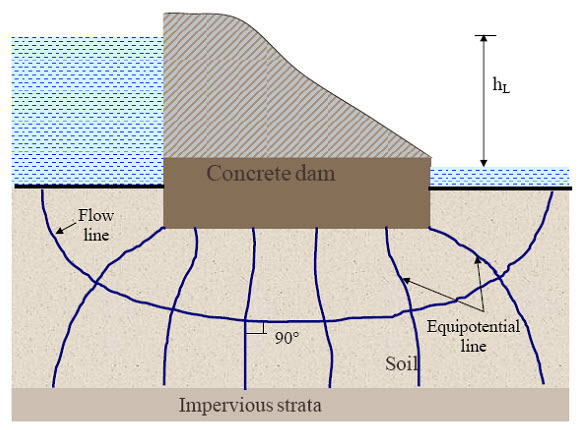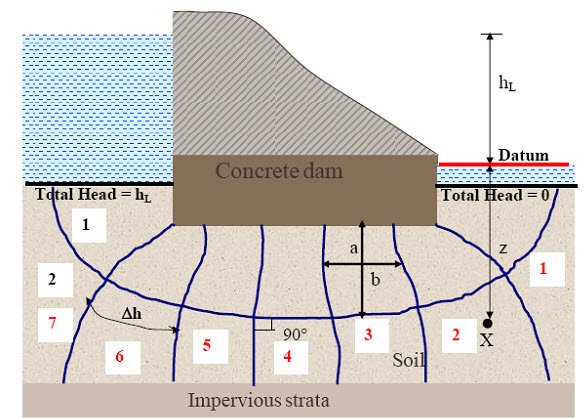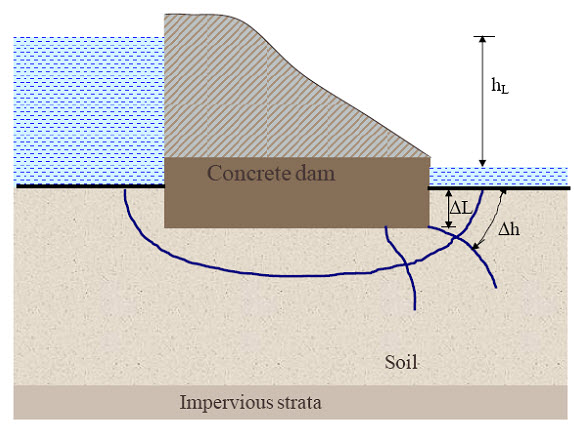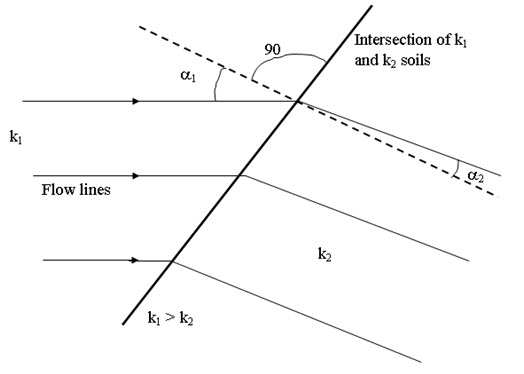Site pages
Current course
Participants
General
MODULE 1. Fundamentals of Soil Mechanics
MODULE 2. Stress and Strength
MODULE 3. Compaction, Seepage and Consolidation of...
MODULE 4. Earth pressure, Slope Stability and Soil...
Keywords
29 March - 4 April
5 April - 11 April
12 April - 18 April
19 April - 25 April
26 April - 2 May
LESSON 20. Flow Net
20.1 Introduction
The flow lines indicate the direction of flow and equipotential lines are the lines joining the points with same total potential or elevation head. From upstream to downstream, total head steadily decreases along the flow line. A network of selected flow lines and equipotential lines is called flow net (as shown in Figure 20.1)

Fig.20.1. Flow net.
From the flow net, the quantity of seepage (Q) is calculated as:
\[Q=k{h_L}{{{N_f}} \over {{N_d}}}\] (20.1)
where k is the coefficient of permeability of soil, hL is head loss from upstream to downstream, Nf is number of flow channels per unit length normal to the plane (in the Figure 20.2, Nf = 2), Nd is the number of equipotential drops (in the Figure 20.2, Nd = 7). If hL is the total head loss during the flow and Nd is the number of equipotential drops, then Δh = hL / Nd (as shown in Figure 20.2).
Total head at a point X = hL - number of drops from upstream × Δh (20.2)
Elevation head = -z (20.3)
Pressure head = Total head – Elevation head (20.4)
It is not necessary to make all the filed elementary squares in a flow net, but a/b ratio (as shown in Figure 20.2) should be same for all the filed elements. If a/b = n, then Eq. (20.1) can be written as:
\[Q=k{h_L}{{{N_f}} \over {{N_d}}}n\] (20.5)
At the downstream, near the dam (as shown in Figure 20.3), the exit hydraulic gradient (iexit) can be determined as:
\[{i_{exit}} = {{\Delta h} \over {\Delta L}}\] (20.6)
If iexit is greater than the critical hydraulic gradient (ic), the soil grains at exit get washed away. This phenomenon progresses towards the upstream and forming a free passage of water. This is called Piping in granular soils. The safety factor against piping can be determined as:
\[{F_{piping}}={{{i_c}} \over {{i_{exit}}}}\] (20.7)
The typical range of Fpiping is 5 to 6.

Fig. 20.2. Use of flow net.

Fig. 20.3 Piping in granular soil.
20.2 Seepage in Anisotropic soil
The Laplace equation presented in previous lesson (lesson 19) is valid for isotropic soil. If soil is anisotropic and coefficient of permeability in x and z direction is not same, the Laplace equation is modified as:
\[{k_x}{{{\partial ^2}h} \over {\partial {x^2}}} + {k_z}{{{\partial ^2}h} \over {\partial {z^2}}}=0\] (20.8)
where kx and kz are the coefficient of permeability in x and z direction, respectively. The Eq. (20.8) can be written as:
\[\frac{{{\partial ^2}h}}{{\frac{{{k_z}}}{{{k_x}}}\partial{x^2}}}+\frac{{{\partial^2}h}}{{\partial {z^2}}}=0\] (20.9)
Convert the x a new coordinate system x' such that
\[x'=x\sqrt {{{{k_z}} \over {{k_x}}}}\] (20.10)
and \[\partial {x'^2}=\partial {x^2}{{{k_z}} \over {{k_x}}}\] , Thus, Eq.(20.9) can be written as:
\[{{{\partial ^2}h} \over {\partial {{x'}^2}}} + {{{\partial ^2}h} \over {\partial {z^2}}}=0\] (20.11)
The Eq.(20.11) is Laplace equation for isotropic soil w.r.t x' and z coordinates. Here x coordinate is transformed to x' coordinate [as per Eq. (20.10)] for converting anisotropic soil medium into a fictitious isotropic medium (by keeping z coordinate unchanged). Thus, during the coordinate transformation horizontal dimension (x dimension) is multiplied by \[\sqrt {{{{k_z}} \over {{k_x}}}}\] . The value of coefficient of permeability for transformed section is taken as:
\[k'=\sqrt {{k_x}{k_z}}\] (20.12)
Thus, in this case the quantity of seepage (Q) is calculated as:
\[Q=\sqrt {{k_x}{k_z}} {h_L}{{{N_f}} \over {{N_d}}}\] (20.13)
20.3 Seepage in Non-Homogeneous Section
Figure 20.4 shows the Change in direction of flow lines at intersection of two soil layers with different permeability. In such situation, the condition is:
\[{{{k_1}} \over {{k_2}}}={{\tan {\alpha _1}} \over {\tan {\alpha _2}}}\] (20.14)
If k1 > k2, the flow lines get defected towards the normal after the intersection (i.e. a1 > a2). Similarly, If k1 < k2, the flow lines get defected away from the normal after the intersection (i.e. a1 < a2). If the permeability of one layer is 10 times more than the permeability of other layer, then it is assumed that no resistance for lowing of water is offered from more pervious layer, thus, no deflection correction is necessary.

Fig.20.4. Change in direction of flow lines at intersection of two soil layers
with different permeability.
References
Ranjan, G. and Rao, A.S.R. (2000). Basic and Applied Soil Mechanics. New Age International Publisher, New Delhi, India.
PPT of Professor N. Sivakugan, JCU, Australia.
Suggested Readings
-
Ranjan, G. and Rao, A.S.R. (2000) Basic and Applied Soil Mechanics. New Age International Publisher, New Delhi, India.
-
Arora, K.R. (2003) Soil Mechanics and Foundation Engineering. Standard Publishers Distributors, New Delhi, India.
-
Murthy V.N.S (1996) A Text Book of Soil Mechanics and Foundation Engineering, UBS Publishers’ Distributors Ltd. New Delhi, India.
-
PPT of Professor N. Sivakugan, JCU, Australia (www.geoengineer.org/files/permy-Sivakugan.pps).